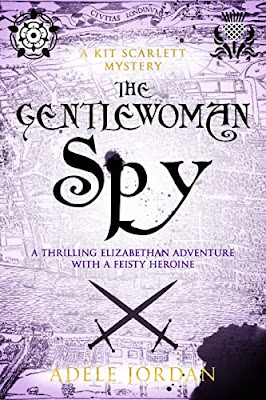Join Kit in a thrilling historical espionage novel! What happens when the spymaster’s right-hand man turns out to be a woman…?
I'm pleased to welcome author Adele Jordan to The Writing Desk:
Tell us about your latest book
What if Walsingham’s right-hand man was a woman? Kit Scarlett works for Elizabethan spymaster, Francis Walsingham, but she’s different to his other spies. As the one woman in his outfit, she’s able to go where no man can go, moving between the underworld and the aristocratic sphere, dressed as a man or a woman when she likes.
Kit knows her purpose – to keep Queen Elizabeth safe. When Walsingham reveals there’s news of a vigilante group preparing to kill the queen and place Mary, Queen of Scots, on the throne, Kit is prepared to do anything to stop it. That also means she must work alongside a Scottish spy, Iomhar Blackwood.
The two are a difficult match. They like to work alone, and with their styles contrasting, the two come up against discovery more than once. Facing a rebel group hidden in the shadows, and a woman prepared to do anything to see her beloved Queen of Scots on the throne, Kit will find she must place her trust in Iomhar if she is to save the Queen of England.
The Gentlewoman Spy is an historical twist on the spy thriller genre. With a heroine prepared to climb rocks to reach castles, fire crossbows, and break into prisons, Kit is a different kind of Tudor woman. She’d much rather wear a hose and jerkin than a corset and a farthingale. She’s certainly courageous, but her daring could lead her into danger.
What is your preferred writing routine?
As a full-time writer, if I’m not working on my own tales, then I’m working on my ghost-writing. This means I get to write for others under pseudonyms, bringing stories to life that are sometimes other people’s ideas or themes. The output is big, and it can be demanding with quick deadline turnarounds and lots of work. That means a lot of time is spent in my study under the skylight windows and at the dark wood desk, with my head bent over the laptop.
I’m not one of those people that say I must do a certain amount of word count each day. I’ll be the first to acknowledge that life doesn’t always make things so easy. Sometimes we need the freedom to change our timetable and having that demanding word count can be an unnecessary pressure. So, I’m not always strict with my output.
Weekends are my days off, and in the weekdays, I have certain times I work between. That can be 7am to 4pm, or 8am to 5pm, and in that time I get as much done as I can, whether that is researching, writing or planning. There was a time when I used to work in the evening too, but these days I close the study door on the writing world and step back.
I think of it being rather like closing the cover on a notebook with that door. The writing is done for the day, and the evening is now free to think of something else. Sometimes, I’ll spend all evening with my mind still imagining another world, so that I go to bed creating new tales in my head, but sometimes, the door is shut for a good reason. We all need a break! That breather to think of other things means I can come back fresh to start again the next morning.
For me, the study is the best place to write. It’s full of books on every shelf, and some plants too, along with a few antiques that just help to inspire that sense of history. I have two framed pictures from the 1860s that are hand-painted prints of engravings made for a woman’s fashion magazine published in London. They are beautiful pictures, evocative of the fashion of the time, and it is this sort of surviving drop from history that helps to inspire when I’m sat there at my desk.
I’ll go out for inspiration when I can, but I’ll never mind being trapped at home to do some work behind my desk when it’s raining outside. After all, I’m not really there – my head is somewhere else. Maybe it’s in Tudor England, Highland Scotland, or Regency London. I can sometimes get so lost in that world that it’s something of a surprise when there’s a knock at the door and I’m reminded I’m still at home in the Mendips.
What advice do you have for new writers?
Practice. I cannot stress that enough. They say, ‘practice makes perfect,’ but I’m going to say that practice makes better. No one knows what is perfect when it comes to writing, or everyone would do it and be a bestseller, but practice certainly brings into context what readers like and how to craft your art.
I started writing when I was young. I remember typing short stories on my parents’ computer on a Saturday afternoon. Even though these were stories that never went anywhere, it was part of the journey. I had the classic training of English at university, and an internship at a short story journal, but the thing that informed my writing the most was writing stories. Some of them will never see the light of day (perhaps that is a very good thing!), but only by doing it did I learn how to get better. It's what I’d encourage any new writer to do.
You need to do your research as well. Keep reading stories, keep watching films, tv and theatre too. Sometimes it’s not about where you find a story, as long as you’re understanding what makes a good tale. Then, put your pen to paper, or fingers to a computer keyboard, and get practicing!
What have you found to be the best way to raise awareness of your books?
I’m still at the beginning of my journey, so I don’t know yet the best way to raise awareness of my books. Something I will say though is to never underestimate the power of speaking to those you meet. I’ve had many conversations with strangers, whether that’s in shoe shops or wandering the beautiful grounds of Montacute House in Somerset, where people ask what you do. Everyone is very kind, they light up when you say you’re a writer and at once, they want to know where to find your book and how to read it.
It's a lovely thing and produces such excitement. After all, as writers all we want is people to enjoy our tales, so when describing them to someone you meet, it’s a real thrill to see how they respond and grow intrigued by the hints of the tale that you drop. Word of mouth! It can be a powerful thing.
Tell us something unexpected during your research?
Before writing The Gentlewoman Spy, I had my nose stuck in records and research books for months on end, even late into evenings when my eyes were falling closed with the need for sleep. That research though was never dull.
One of the best things I read in my time doing the research was Ruth Goodman’s How to Behave Badly in the Renaissance. Anyone who is looking for a good laugh as they do some research for this era, I would recommend that you pick up this book. I discovered many unexpected and entertaining things.
It seems that when women were found to fight in this era, their outbursts were directed mostly at the other ladies’ heads. Coifs were dragged off, hats discarded, and locks were pulled loose. The idea was that to show your hair too much was a very sexual thing, so by doing so, you were suggesting the woman you were attacking was a harlot. Baffling in this day and age, but scandalous if you lived in Renaissance Britain.
This was just one of the surprising things I found. I learned how to bow to make fun of your superior, how to walk behind a soldier to mock him, how to pull hand signals that were disgusting or belittling, though today such signals would look more like trying to recreate a bunny’s ears. There’s how to walk up a set of stairs without tripping on your hem (moving your legs in an inwardly circular motion before taking a step up), and how a woman could upset a man simply by wearing her hat at a jaunty angle. I have a feeling I would have found the latter just too tempting to refuse… A simple rebellion, but who could resist?
What was the hardest scene you remember writing?
No one likes to make their hero weak, but Kit has a weakness, like any other good character. When we first meet Kit, she is afraid of water. Never having learnt to swim, it’s a challenge that she comes up against repeatedly, and that fear can petrify her. The suspension in water, not just in terms of the action of a scene, but writing the mental anguish as well, is not an easy thing to create. It is these moments where Kit is hovering in water that everything has to fall still… Can she escape the water? Or is she lost to her fears?
I think it’s something we can all relate to, this feeling of being incapable of combating our fear. It’s a very hard scene to write, but I hope, in the end, it is something that readers can relate to, whilst praying she can get back out of the water again.
What are you planning to write next?
Kit Scarlett’s next two adventures are already in the pipeline, so now I’m onto her fourth. A thrilling adventure where she’s off to Scotland, in search of Iomhar Blackwood’s past. Hopefully, a research trip to Scotland will be needed!
Adele Jordan
# # #
About the Author

Adele Jordan is a writer with a fascination for history. Her focus is fiction in the Tudor era, telling the stories of women and adventure. Whether it’s inspired by true events or created purely from imagination, she desires to write stories from this captivating era that haven’t been written before of those on the edges of society, the paupers, the spies, the workers and those who have not had a voice. Adele studied English at the University of Exeter before moving into an eclectic career of publishing and marketing. Having worked with the National Trust’s photography department for two years, Adele travelled the country to visit the landscapes and historical places that have carved England and Wales’ heritage. When Covid struck, the job disappeared overnight, and Adele committed her time to ghost writing and authoring her own stories. Since then, she has had over twenty successful books published as a ghostwriter and hopes to turn that success into stories now written in her own name. Find out more at Adele's
website and follow her on Twitter
@ALJordan_writer





























